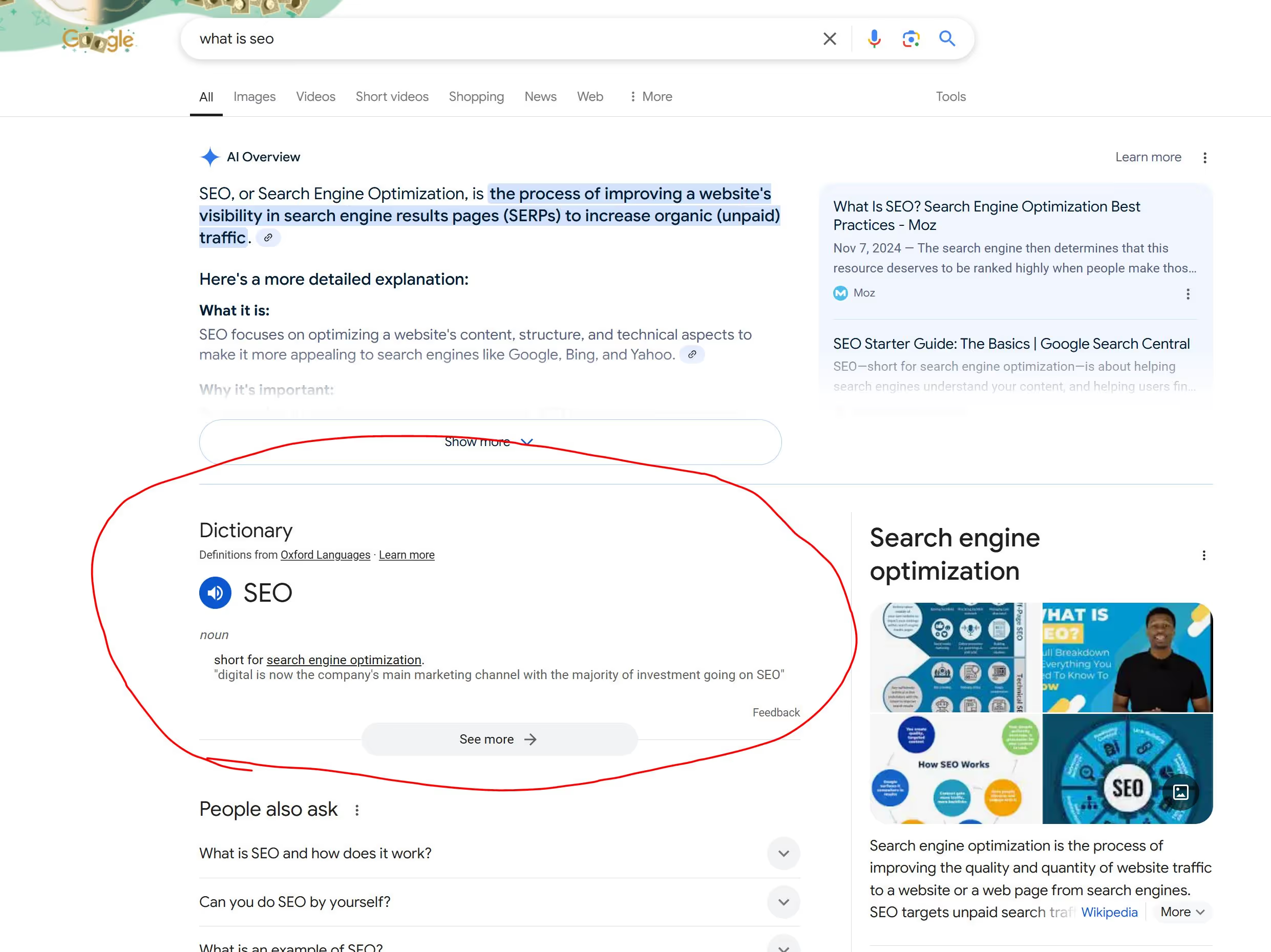
Summary
- SERP Features dominate search results, boosting visibility and driving more clicks.
- Featured snippets, PAA boxes, and local packs enhance search engagement.
- Optimizing for SERP Features requires structured content, SEO best practices, and data.
- Ignoring SERP Features risks losing traffic, even with a high-ranking page.
What Are SERP Features?
SERP stands for "Search Engine Results Page," and SERP features refer to the additional components displayed on these pages beyond the standard list of organic search results.
Common SERP features include featured snippets, image carousels, local packs, video carousels, "People Also Ask" boxes, and rich results (such as review ratings or recipe details).
These features enhance the search experience by quickly delivering relevant information directly on the results page, making them highly visible and valuable for users.
Why Do SERP Features Matter for SEO?
SERP features significantly impact SEO because they occupy prominent positions on the search results page, capturing user attention and influencing clicks.
Ranking within these features can substantially increase visibility, credibility, and website traffic.
Conversely, neglecting SERP feature optimization can reduce the visibility of even top-ranking organic results, as users tend to engage first with visually appealing and informative features at the top of the page.
Notable statistics:
- Featured snippets can capture approximately 35% of clicks from the top organic search result (Ahrefs).
- "People Also Ask" boxes may redirect users to explore related content, potentially decreasing traffic to sites not featured.
The bottom line: You’re not just competing for rank; you’re competing for visibility in the SERP Features list too.
Types of SERP Features & How To Use Them
Below are several key SERP features and strategies to optimize for them:
1. Featured Snippets
Featured snippets provide direct answers to user queries and are displayed at the top of search results, often called position zero.
They typically include a short paragraph, list, or table directly answering the user's question.

How to Optimize for Featured Snippets
To optimize for featured snippets, clearly structure your content with descriptive headings, bullet points, and numbered lists.
Create concise yet informative answers that precisely match common user queries.
Additionally, focus on formatting content in a way that Google can easily extract for featured snippets, such as utilizing FAQ sections or addressing questions explicitly within your text.
2. People Also Ask (PAA) Boxes
"People Also Ask" (PAA) boxes contain expandable questions related to the original query, each revealing brief answers when clicked.
Users often engage deeply with these to explore more information on related topics.

How to Optimize for PAA Boxes
To optimize for PAA, conduct comprehensive keyword research to uncover commonly asked questions related to your primary content.
Integrate these questions directly into your content and provide succinct yet thorough answers.
Structuring content with clear questions and answers can help Google identify your content as suitable for inclusion in PAA boxes.
3. Local Pack
The Local Pack is a map-based feature that prominently displays local businesses relevant to geographic or "near me" searches, typically showing business names, addresses, phone numbers, reviews, and ratings.

How to Optimize for Local Packs
Optimizing your visibility in the Local Pack involves consistently managing and updating your Google Business Profile.
Ensure that your profile has accurate contact information, operating hours, and location details.
Regularly encourage satisfied customers to leave positive reviews, respond promptly to customer queries and feedback, and include attractive, relevant photos to boost your local ranking.
4. Image Packs
Image packs appear prominently for queries where visual content plays an important role, such as product searches, fashion, recipes, or destinations.

How to Optimize for Image Packs
Optimizing for image packs requires attention to detail in how images are integrated into your content.
Ensure images have meaningful, keyword-rich alt text and relevant filenames.
Surround images with descriptive text related to your target keywords, providing context that enhances the relevance and visibility of your visuals in search results.
High-quality, visually engaging images can further enhance user engagement.
5. Video Carousels
Video carousels highlight relevant video content, particularly for educational, instructional, or "how-to" searches.
These carousels often appear in a prominent position and capture user attention effectively.

How to Optimize for Video Carousels
Optimize each video on platforms such as YouTube by writing descriptive, keyword-rich titles, thorough descriptions, detailed tagging, and accurate transcripts or closed captions.
This comprehensive optimization helps ensure your video content is easily discoverable, engaging, and relevant, thereby increasing its chances of featuring prominently.
6. Rich Results (Reviews, Recipes, Etc.)
Rich results display additional structured details directly in the SERPs, such as star ratings for products, cooking times and nutritional information for recipes, event dates, or pricing details.

How to Optimize for Rich Results
To optimize your content for rich results, implement structured data markup (JSON-LD schema) effectively throughout your website.
Clearly define and accurately tag relevant information such as reviews, product specifics, or event details.
Regularly validate your structured data with Google's testing tools to ensure correctness and maximize your chances of having your content prominently displayed as rich results.
The Challenges with SERP Features (And How to Overcome Them)
Optimizing for SERP features includes several challenges:
CompetitionSERP features are highly coveted, making the competition fierce
Solution: Produce authoritative, high-quality content tailored to user intent, addressing specific queries comprehensively and clearly.
Frequent ChangesGoogle consistently updates its algorithms and introduces or retires various SERP features.
Solution: Regularly conduct SEO audits and utilize tools like SEMrush or Ahrefs to monitor trends and adapt quickly.
Zero-click SearchesSome SERP features provide sufficient information on the search results page, resulting in fewer clicks to websites.
Solution: Craft engaging content with clear calls to action (CTAs) that encourage further exploration beyond the displayed snippet.
Why You Cannot Ignore SERP Features
SERP features have evolved into essential elements of search visibility.
Ignoring these features limits the effectiveness of any digital marketing strategy.
Optimizing content to appear prominently in these sections is crucial for maintaining a competitive advantage in modern SEO.
About this term
Learn about this term and how it relates to digital marketing.




